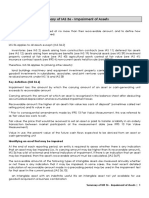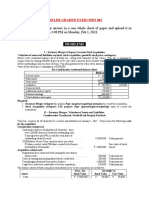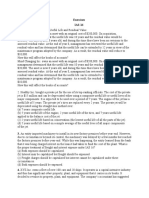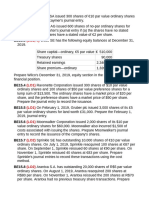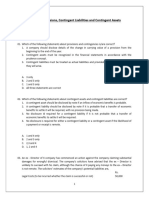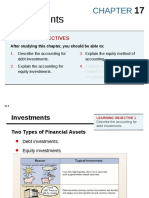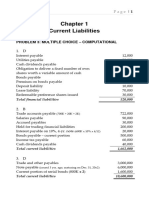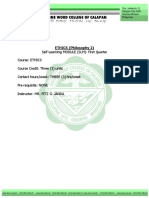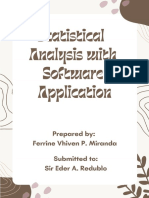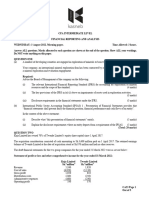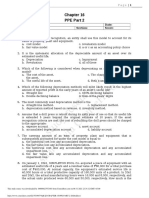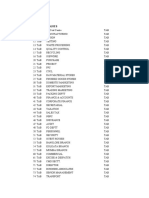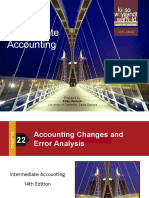IAS 36 Impairment of Assets Illustrative Examples PDF
IAS 36 Impairment of Assets Illustrative Examples PDF
Uploaded by
Maey RoledaCopyright:
Available Formats
IAS 36 Impairment of Assets Illustrative Examples PDF
IAS 36 Impairment of Assets Illustrative Examples PDF
Uploaded by
Maey RoledaOriginal Description:
Copyright
Available Formats
Share this document
Did you find this document useful?
Is this content inappropriate?
Copyright:
Available Formats
IAS 36 Impairment of Assets Illustrative Examples PDF
IAS 36 Impairment of Assets Illustrative Examples PDF
Uploaded by
Maey RoledaCopyright:
Available Formats
lOMoARcPSD|9376998
IAS 36: IMPAIRMENT OF ASSETS – ILLUSTRATIVE EXAMPLES
Illustrative example 11.1: Calculation of recoverable amount
Roach Limited has an item of plant which has undergone an impairment review at 31 December 20.1. At the
review, the following estimates were produced.
Fair value of plant: R1 400 000
Costs of disposal: 2% of selling price
Revenue and associated costs per annum for remaining useful life: (assume all cash flows occur at the end of
the year):
Revenue Costs
20.2 R960 000 R240 000
20.3 R880 000 R220 000
20.4 R700 000 R290 000
The plant has an estimated residual value of R50 000. A discount rate of 10% is applicable to investments
equivalent in risk to this plant.
Required:
Calculate the recoverable amount as at 31 December 20.1
Solution:
Cash Flows 20.2 20.3 20.4
Rand Rand Rand
Revenue 960 000 880 000 700 000
Costs (240 000) (220 000) (290 000)
Net cash inflow 720 000 660 000 410 000
Present value factor 0.90909 0.82645 0.75131
Present value 654 545 545 457 308 037
Residual value present value (end of 20.4: 50 000 x 0.75131) = 37 566
Value in use = (654 545 + 545 457 + 308 037 + 37 566) = R1 545 605
Fair value less cost of disposal = R1 400 000 x 98% = R1 372 000
Recoverable amount (greater of) = value in use = R 1 545 605
Illustrative example 11.2: Individual asset carried at depreciated historic cost
A pharmaceutical company’s competitor ‘invented’ a cheap cure for HIV/AIDS. This resulted in the
company moth-balling its less effective HIV/AIDS treatment drug manufacturing plant on 31 December
20.8.
Details of the moth-balled plant are as follows:
R’000
Original cost (1 January 20.6) 1 000
Recoverable amount (31 December 20.8) zero
Depreciation is provided for on the straight-line basis over 10 years to nil residual value.
In December 20.9, it became apparent that the competitor’s ‘miracle’ cure was a hoax. Fortunately, the
company had not disposed of its moth-balled plant and plans to recommence production in the 20.10
financial year. Market demand for the company’s HIV/AIDS treatment drug is fully restored and the plant
is once again expected to run profitably in the foreseeable future.
Required:
Prepare journal entries to record the write down to recoverable amount and subsequent write back.
Downloaded by Unknown Wanderer (unknownwanderer4ever@gmail.com)
lOMoARcPSD|9376998
IAS 36: IMPAIRMENT OF ASSETS – ILLUSTRATIVE EXAMPLES
Solution: Calculation: Debit Credit
R’000 R’000
31 December 20.8
Depreciation – plant R1 000 000/10 years 100
Accumulated depreciation & impairment - plant 100
Depreciation for the year
Impairment of plant – expense (R1 000 000 cost – R300 000 700
Accumulated depreciation & impairment - plant accumulated depreciation) – 700
R0 recoverable amount
Impairment of plant
31 December 20.9
Accumulated depreciation & impairment - plant R700 000 above – R100 000 600
Reversal of impairment - expense notional depreciation 600
Reversal of impairment
Illustrative example 11.3: Individual asset carried at revalued amount
Zuma Limited, a listed pharmaceutical manufacturer, acquired its Mirodene plant on 1 January 20.1 at a
cost of R100 million. Mirodene is a drug used exclusively by HIV/AIDS patients to prolong and improve
the quality of their remaining lives.
Zuma Limited depreciates plant on the straight-line method to nil residual values, over 10 years. The
South African Revenue Services allows wear and tear on the straight-line method, to nil residual values,
over 5 years.
On 1 January 20.3, Zuma Limited revalued its Mirodene plant up to a carrying amount of R200 million.
On 30 December 20.4 Nkosazana Limited, a major competitor, made a public announcement to the effect
that it had developed Silodene, a miracle cure for HIV/AIDS. This development caused Zuma Limited to
drastically reduce production at the Mirodene plant and to reduce the carrying amount of the Mirodene
plant to R10 million.
Production at reduced levels continued throughout 20.5 and 20.6.
On 2 January 20.7, the World Health Organisation banned the use of Silodene, as not only had it become
apparent that Silodene did not cure HIV/AIDS, but that it also caused lung cancer. The market for
Mirodene was immediately restored and Zuma Limited therefore revalued its Mirodene plant up to a
carrying amount of R160 million.
The Mirodene plant was disposed of for R100 million cash to a foreign investor on 3 January 20.9.
At all times, management considered the useful life of the Mirodene plant to be 10 years from the date of
acquisition.
The corporate normal tax rate was 40% throughout. Other than as can be ascertained from the information
provided, there are no differences between taxable income and accounting profit. The company creates
deferred taxation assets as it has convincing evidence that any such asset would be recovered.
Zuma Limited releases the realised portion of the revaluation surplus reserve directly to retained earnings.
Required:
1. Prepare the journal entries (including those in respect of deferred taxation and bank) ascertainable from
the information provided from 1 January 20.1 to 31 December 20.9. The company operates a single plant
account and uses the net replacement cost method (i.e. you are not required to differentiate between the
gross carrying amount and accumulated depreciation and accumulated impairment).
2
Downloaded by Unknown Wanderer (unknownwanderer4ever@gmail.com)
lOMoARcPSD|9376998
IAS 36: IMPAIRMENT OF ASSETS – ILLUSTRATIVE EXAMPLES
2. Prepare extracts from the statement of financial position (including notes), statement of changes in
equity (including notes), and statement of profit or loss and other comprehensive income (including notes)
for inclusion in the 20.4 and 20.7 annual financial statements.
Comparative figures are not required.
Solution:
1. Journals
Calculation: Debit Credit
R’000 R’000
20.1
Plant Given 100 000
Bank 100 000
1 January 20.1: Acquisition of plant
Depreciation – plant R100 000/10 years 10 000
Plant 10 000
31 December 20.1: Depreciation for the year
Deferred taxation expense 40%[(R0 CA – R0 TB) – (R90 000 CA – R80 000 TB)] 4 000
Deferred taxation liability 4 000
31 December 20.1: Deferred taxation for the year
20.2
Depreciation – plant R100 000/10 years 10 000
Plant 10 000
31 December 20.2: Depreciation for the year
Deferred taxation expense 40%[R90 000 CA – 80 000 TB) – 4 000
(R80 000 CA – R60 000 TB)]
Deferred taxation liability 4 000
31 December 20.2: Deferred taxation for the year
20.3
Plant R200 000 net replacement cost – R80 000 carrying 120 000
amount
Revaluation surplus - OCI 60%(R120 000 revaluation) 72 000
Deferred taxation - liability 40%(R120 000 revaluation) 48 000
1 January 20.3: Revaluation
20.3
Depreciation R200 000/8 years 25 000
Plant 25 000
31 December 20.3: Depreciation
Revaluation surplus - OCI 60%(15 000 revaluation depreciation) or 9 000
Retained earnings R72 000/8 years 9 000
31 December 20.3: Release realized portion of RSR to RE
Deferred taxation – liability 40%[(o/b: 200 000 CA – 60 000 TB) – (c/b: 175 000 2 000
CA – 40 000 TB)]
Deferred taxation - expense 2 000
31 December 20.3: Deferred tax for the year
Downloaded by Unknown Wanderer (unknownwanderer4ever@gmail.com)
lOMoARcPSD|9376998
IAS 36: IMPAIRMENT OF ASSETS – ILLUSTRATIVE EXAMPLES
20.4
Depreciation R200 000/8 years 25 000
Plant 25 000
31 December 20.4: Depreciation
Revaluation surplus - OCI 60%(15 000 revaluation depreciation) 9 000
Retained earnings or R72 000/8 years 9 000
31 December 20.4: Release realized portion of RSR to RE
Revaluation surplus reserve - OCI 60%(150 000 CA – 60 000 NHC) 54 000
Deferred taxation - liability 40%(150 000 CA – 60 000 NHC) 36 000
Impairment of plant – expense R60 000 NHC – R10 000 RA 50 000
Plant R150 000 CA – R10 000 recoverable amount 140 000
31 December 20.4: Impairment of plant
Deferred taxation – liability 40%[(o/b: 175 000 CA – 40 000 TB) – (c/b: 10 000 22 000
CA – 20 000 TB)] – R36 000 above
Deferred taxation - expense 22 000
31 December 20.4: Deferred taxation for the year
20.5
Depreciation R10 000/6 years 1 667
Plant 1667
31 December 20.5: Depreciation for the year
Deferred taxation – expense 40%[(o/b: 10 000 CA – 20 000 TB) – 7 333
(c/b: 8 333 CA –0 TB)]
Deferred taxation – liability 7 333
31 December 20.5: Deferred tax for the year
20.6
Depreciation R10 000/6 years 1 667
Plant 1667
31 December 20.6: Depreciation for the year
Deferred taxation – liability 40%[(o/b: 8 333 CA –0 TB) – 667
(c/b: 6 666 CA –0 TB)]
Deferred taxation – expense 667
31 December 20.6: Deferred tax for the year
20.7
Plant R160 000 new carrying amount – R6 666 old carrying 153 333
amount
Reversal of impairment – P/L R40 000 – R6 666 33 334
Revaluation surplus - OCI 60%(R120 000 revaluation in excess of depreciated 72 000
historic cost)
Deferred taxation – liability 40%(R120 000) 48 000
1 January 20.7: Reversal of impairment and revaluation
Depreciation R160 000/4 years 40 000
Plant 40 000
31 December 20.7: Depreciation for the year
Revaluation reserve 60%(30 000 revaluation depreciation) or 18 000
Retained earnings R72 000/4 years 18 000
31 December 20.7: Realised portion released to retained earnings
Deferred taxation – liability 40%[(o/b: 6 666 CA –0 TB) – 2 666
(c/b: 120 000 CA –0 TB)] + R48 000 above
Deferred taxation – expense 2 666
31 December 20.7: Deferred taxation for the year
Downloaded by Unknown Wanderer (unknownwanderer4ever@gmail.com)
lOMoARcPSD|9376998
IAS 36: IMPAIRMENT OF ASSETS – ILLUSTRATIVE EXAMPLES
20.8
Depreciation R160 000/4 years 40 000
Plant 40 000
31 December 20.8: Depreciation for the year
Revaluation reserve 60%(30 000 revaluation depreciation) 18 000
Retained earnings or R72 000/4 years 18 000
31 December 20.8: Realised portion released to retained earnings
Deferred taxation – liability 40%[(o/b: 120 000 CA –0 TB) – 16 000
(c/b: 80 000 CA –0 TB)]
Deferred taxation – expense 16 000
31 December 20.8: Deferred taxation for the year
20.9
Bank Given 100 000
Plant R160 000 (from 20.7 revaluation) x 2/4 years 80 000
remaining
Profit on disposal of plant Balancing figure 20 000
3 January 20.9: Disposal of plant
Deferred taxation – liability 40%[(o/b: 80 000 CA – 0 TB) – 32 000
(c/b: 0 CA – 0 TB)]
Deferred taxation – expense 32 000
31 December 20.9: Deferred taxation for the year
Revaluation reserve 60%(R80 000 CA – R20 000 DHC) 36 000
Retained earnings 36 000
31 December 20.9: Release remaining balance of RSR to RE
As alternatives to journals, workings can be produced in table or graph formats. Shown below is a table
format. This is somewhat quicker and easier than journals and makes the task of subsequent disclosure
relatively easy.
Downloaded by Unknown Wanderer (unknownwanderer4ever@gmail.com)
lOMoARcPSD|9376998
IAS 36: IMPAIRMENT OF ASSETS – ILLUSTRATIVE EXAMPLES
WORKINGS
Zuma Limited – Table
R’000 R’000 R’000 R’000 R’000
Date Historical Carrying Tax Def Tax Reval
Cost Amount Base (40%) * Reserve
1 Jan 20.1 100 000 100 000 100 000
Depreciation 20.1 (10 000) (10 000) (20 000)
31 Dec 20.1 90 000 90 000 80 000 4 000
Depreciation 20.2 (10 000) (10 000) (20 000)
31 Dec 20.2 80 000 80 000 60 000 8 000
1 Jan 20.3 Revaluation 120 000 72 000
Depreciation 20.3 (10 000) (25 000) (20 000) (9 000)
31 Dec 20.3 70 000 175 000 40 000 54 000 63 000
Depreciation 20.4 (10 000) (25 000) (20 000) (9 000)
31 Dec 20.4 Reversal of reval (90 000) (54 000)
31 Dec 20.4 Impairment (50 000)
31 Dec 20.4 60 000 10 000 20 000 (4 000) -
Depreciation 20.5 (10 000) (1 667) (20 000)
31 Dec 20.5 50 000 8 333 - 3 333 -
Depreciation 20.6 (10 000) (1 667)
31 Dec 20.6 40 000 6 666 - 2 666 -
2 Jan 20.7 Reversal of impairment 33 334
40 000
2 Jan 20.7 Revaluation 120 000 72 000
Depreciation 20.7 (10 000) (40 000) (18 000)
31 Dec 20.7 30 000 120 000 - 48 000 54 000
Depreciation 20.8 (10 000) (40 000) (18 000)
31 Dec 20.8 20 000 80 000 - 32 000 36 000
3 Jan 20.9 Disposal (20 000) (80 000) (32 000) (36 000)
-- -- -- -- --
* Carrying amount less tax base x 40%
2. Disclosure
ZUMA LIMITED
PARTIAL STATEMENT OF FINANCIAL POSITION AT 31 DECEMBER 20.7 and 20.4
Note 20.7 Calculation: 20.4 Calculation:
R’000 R’000
ASSETS
Non-current assets
Property, plant and equipment 11 120 000 R160 000 x 3/4 years 10 000 Given @ 30 December
20.4
Deferred taxation 13 - 4 000 40%(10 000CA –
20 000TB)
EQUITY AND LIABILITIES
Issued share capital and reserves 12 ? ?
Deferred taxation 13 48 000 40%(120 000CA – 0TB) -
Downloaded by Unknown Wanderer (unknownwanderer4ever@gmail.com)
lOMoARcPSD|9376998
IAS 36: IMPAIRMENT OF ASSETS – ILLUSTRATIVE EXAMPLES
ZUMA LIMITED
PARTIAL STATEMENT OF COMPREHENSIVE INCOME
FOR THE YEAR ENDED 31 DECEMBER 20.7 and 20.4
Note 20.7 Calculation: 20.4 Calculation:
R’000 R’000
Other comprehensive income:
Reversal of revaluation - (54 000) 60%(R150 000CA –
R60 000DHC)
Revaluation 120 000 (R160 000 – -
R40 000DHC)
Income tax on revaluation (48 000) -
? ?
ZUMA LIMITED
PARTIAL STATEMENT OF CHANGES IN EQUITY
FOR THE YEAR ENDED 31 DECEMBER 20.4
Revaluation Retained TOTAL
surplus earnings
Calculation: reserve R’000
Balance at 1 January 20.4 60%(R175 000CA – R70 000DHC) 63 000 ? ?
Total comprehensive income for the year (54 000) ? ?
Transfer upon realisation 60%(R15 000 revaluation (9 000) 9 000 -
depreciation)
Balance at 31 December 20.4 - ? ?
ZUMA LIMITED
PARTIAL STATEMENT OF CHANGES IN EQUITY
FOR THE YEAR ENDED 31 DECEMBER 20.7
Calculation: Revaluation Retained TOTAL
surplus earnings
reserve R’000
Balance at 1 January 20.7 - ? ?
Total comprehensive income for the year 72 000 - ?
Transfer upon realisation 60%(R30 000 revaluation (18 000) 18 000 -
depreciation
Balance at 31 December 20.7 54 000 ? ?
ZUMA LIMITED
PARTIAL NOTES TO THE FINANCIAL STATEMENTS
FOR THE YEAR ENDED 31 DECEMBER 20.7 and 20.4
Note 1: Accounting policies
Property, plant and equipment
Plant is revalued at three year intervals to its fair value in existing use at the beginning of the year.
Revaluations are accounted for on the net replacement cost method.
The realised portion of the revaluation surplus reserve is released to retained earnings annually.
Plant is depreciated on the straight-line method to nil residual values over ten years from the date of
acquisition.
20.7 20.4
Note 2: Profit from operations Calculation: R’000 R’000
Profit from operations is stated after:
Depreciation - owned plant 40 000 25 000
(Reversal of impairment)/ impair- 20.7: R40 000DHC – R6 666CA
20.4: R60 000DHC – R10 000 recoverable amount
met of plant (33 334) 50 000
Note 3: Income taxation
South African income tax 20.7: 40%[(6 666CA – 0 TB) –
Downloaded by Unknown Wanderer (unknownwanderer4ever@gmail.com)
lOMoARcPSD|9376998
IAS 36: IMPAIRMENT OF ASSETS – ILLUSTRATIVE EXAMPLES
Deferred (c/b: 120 000CA – 0 TB)] + R48 000 ( 2 666) (22 000)
20.4: 40%[(175 000CA – 40 000 TB) –
(c/b: 10 000CA – 20 000TB)] – R36 000
Note 11. Property, plant and equipment
20.7 20.4
Calculation: Plant Plant Calculation:
R’000 R’000
Valuation 250 000 250 000 R100 000HC/
R80 000DHC x
R200 000CA
Accumulated depreciation and impairment (243 334) (75 000)
1 January 6 666 175 000
Revaluation R160 000 – R100 000 60 000 -
Reversal of prior period
R100 000 – R40 000DHC
devaluation 60 000 -
Reversal of prior period impairment R40 000DHC – R6 666CA 33 334 -
Depreciation R160 000/4 years ( 40 000) ( 25 000) R200 000/8 years x 1 year
Reversal of prior period revaluation - ( 90 000) R150 000CA –
R60 000DHC
Impairment expensed - ( 50 000) R60 000DHC –
R10 000RA
31 December 120 000 10 000
Comprised of:
Valuation 250 000 250 000
Accumulated depreciation and impairment (130 000) (240 000)
Carrying amount 120 000 10 000
Depreciated historic cost R100 000 x 3/10 years 30 000 10 000 *
* Depreciated historic cost can never be greater than the asset’s carrying amount at reporting date.
20.4: Impairment of plant
A competitor began the commercial production of a product that greatly reduced the market for the
company’s HIV/AIDS treatment product and consequently the company impaired its Mirodene plant
to its recoverable amount. The recoverable amounts were determined in accordance with IAS 36, at the
plant’s value in use, determined at a discount rate of x%. These assets had not previously been tested
for impairment as the Mirodene market was lucrative and the probability of an HIV/AIDS curing drug
was considered to be remote. Mirodene manufacturing is reported in the pharmaceutical segment.
20.7: Reversal of impairment of plant
The World Health Organisation banned a competitor’s incorrectly alleged HIV/AIDS curing drug
during the year. This restored the viability of the company’s previously impaired Mirodene HIV/AIDS
treatment and the commercial production of this product to a greatly improved market share.
Plant carried at revalued amounts was revalued by independent valuers’ NAME. The effective date of
the most recent valuation is 2 January 20.7.
Note 12: Issued share capital and reserves
The purpose of the revaluation surplus reserve is to record the unrealised (net of deferred tax) portion
of the increase resulting from the revaluation of plant.
Note 13: Deferred taxation liability
20.7 20.4
Calculation: R’000 R’000 Calculation:
40% (10 000CA –
Balance at 31 December – plant 40% (120 000CA – 0TB) 48 000 ( 4 000) 20 000CA)
Downloaded by Unknown Wanderer (unknownwanderer4ever@gmail.com)
lOMoARcPSD|9376998
IAS 36: IMPAIRMENT OF ASSETS – ILLUSTRATIVE EXAMPLES
Illustrative example 11.4: Impairment review
On 1 January 20.4, Retail Limited acquired the Petrol brand name at a cost of R200 million. The Petrol
brand is now legally registered to Retail Limited and has been assessed by Retail Limited’s directors
as having an indefinite useful life. Utilisation of the Petrol brand has resulted in Retail Limited being
able to brand its merchandise and sell it at a 50% premium to its pre-branding selling price. In
accordance with IAS 36 the Petrol brand was tested for impairment at 31 December 20.4 when its
recoverable amount (i.e. value in use) was determined to be R300 million (i.e. R100 million in excess
of its carrying amount).
During 20.5, the Petrol brand continued to perform beyond the directors’ expectations resulting in
Retail Limited recording a record profit for the second year in succession. The directors have no reason
to believe that this trend in future profitability will decline and are most pleased with the performance
of the Petrol brand.
Required:
Discuss the measures that IAS 36 ‘requires’ Retail Limited to undertake during 20.5 in respect of the
Petrol brand.
Solution:
Impairment indicator review
At 31 December 20.5 Retail Limited is required to carry out an impairment indicator review considering
external and internal sources of information. If the impairment indicator review reveals that there are
indications that the assets of Retail Limited may be impaired then an impairment test must be conducted
(i.e. the recoverable amount of the assets must be determined). In the case of Retail Limited at 31
December 20.5 the impairment indicator review is unlikely to find indications of impairment given that
the Petrol brand exceeded all performance expectations and that the company is recording record profits
and is expected to continue to do so for the foreseeable future.
Indefinite useful life intangible asset
Irrespective of whether there is any indication of impairment, the recoverable amount of the Petrol
brand (because it has an indefinite useful life) must be estimated at 31 December 20.5
However, because at 31 December 20.4 the recoverable amount of the Petrol brand was computed (in
detail) to be R300 million, that value may be used in lieu of a detailed impairment test being conducted
during 20.5 because all of the following criteria are satisfied:
in the most recent impairment test the recoverable amount exceeded the carrying amount by a
substantial margin (evidenced by the 31 December 20.4 impairment test that showed the
recoverable amount exceeded the carrying amount by 50% of the carrying amount); and
the likelihood that the current recoverable amount would be less than the affected asset’s
carrying amount is remote (evidenced by the improved profitability of the company being
attributed to the Petrol brand whose performance has exceeded the expectations of the directors
and is expected to continue to do so for the foreseeable future).
Illustrative example 11.5: Impairment testing
One of the machines (Machine 5A) in a production line has suffered damage due to the negligence of
its operator. Although the damaged machine is currently operating less than optimally, and its estimated
remaining useful life has been revised downward from ten years to two years, the CGU’s value in use
(taken as a whole) remains well in excess of its carrying amount.
Required:
Under each of the following circumstances briefly outline whether Machine 5A should be impaired:
Downloaded by Unknown Wanderer (unknownwanderer4ever@gmail.com)
lOMoARcPSD|9376998
IAS 36: IMPAIRMENT OF ASSETS – ILLUSTRATIVE EXAMPLES
Scenario X: The directors intend keeping Machine 5A in existing use for the foreseeable
future.
Scenario Y: The directors have taken the decision to scrap Machine 5A and have ordered a
replacement machine which is expected to arrive within two weeks.
Solution:
Scenario X:
The Machine 5A cannot be tested for impairment on its own as its value in use is dependent upon the
other machines in the CGU. As the value in use of the CGU exceeds its carrying amount the CGU is
not impaired and consequently Machine 5A cannot be impaired.
Scenario Y:
Because the decision has been taken to scrap Machine 5A immediately its recoverable amount
approximates R0. The recoverable amount is Machine 5A’s value in use, which is R0 as it will generate
no future cash flows. Machine 5A therefore is removed from the CGU and tested for impairment as an
individual asset. Consequently, the entire remaining carrying amount of Machine 5A would be
expensed.
Illustrative example 11.6: Allocation of impairment loss
A CGU whose recoverable amount is R12 000 has the following assets:
Carrying Fair value less costs of
amount disposal
Rand Rand
- Motor vehicle 4 000 4 000
- Plant 1 000 ?
- Factory building 10 000 7 000
- Registered fixed period patent 5 000 ?
20 000
The resultant impairment of R8 000 (calculation: R20 000 carrying amount – R12 000 recoverable amount) shall be
allocated to the individual assets of the entity as follows:
Impair- Carried
ment forward
Calculation: Rand Rand
First round of allocation:
- Motor vehicle R4 000/R20 000 x R8 000 impairment: limited to nil - 1 600
- Plant R1 000/R20 000 x R8 000 impairment 400 -
- Factory building R10 000/R20 000 x R8 000 impairment limited to R3 000 3 000 1 000
- Fixed period patent R5 000/R20 000 x R8 000 impairment 2 000 -
5 400 2 600
Second round of allocation:
- Plant (R600 plant)/(R600 plant + R3 000 patent) x R2 600 433 -
impairment carried forward from first allocation
- Fixed period patent (R3 000 patent)/(R600 plant + R3 000 patent) x R2 600 2 167 -
impairment carried forward from first allocation
2 600 -
Illustrative example 11.7: Reversal of impairment
On 31 December 20.3, as a result of the South African Government imposing a ban on tobacco product
advertisements in South Africa, Bustandboom Limited impaired its tobacco cash-generating unit down
to its recoverable amount of R1 million.
10
Downloaded by Unknown Wanderer (unknownwanderer4ever@gmail.com)
lOMoARcPSD|9376998
IAS 36: IMPAIRMENT OF ASSETS – ILLUSTRATIVE EXAMPLES
During 20.5, as a result of an aggressive advertising campaign in China, the profitability of
Bustandboom Limited’s tobacco cash-generating unit was fully restored. On 31 December 20.5, the
recoverable amount of the tobacco cash-generating unit was reliably determined at R5 million.
The carrying amount of the tobacco cash-generating unit’s plant was not adjusted on 1 January 20.4 as
the carrying amount before the valuation was not materially different to its fair value on that date.
The plant and factory building are depreciated on the straight-line method to nil residual values.
Goodwill is carried at cost and tested for impairment annually. The implied fair value of goodwill on
31 December 20.3 was R0.
Details of the assets of Bustandboom Limited’s tobacco cash-generating unit, all of which arose from
the acquisition, on 1 January 20.1, of a competitor’s net assets, are as follows:
Remaining
useful life Cost Fair value less costs of disposal
1 January 1 January 31 December 31 December
20.1 20.1 20.3 20.5
Years Rand Rand Rand
Plant 15 3 000 000 100 000 2 000 000
Building 10 2 000 000 300 000 1 000 000
Goodwill Indefinite 571 429 ? ?
5 571 429
Required:
Compute, in accordance with IFRS, for each of the assets of Bustandboom Limited’s tobacco cash-
generating unit:
The impairment expense charged to profit or loss for the year ended 31 December 20.3; and
the impairment reversal credited profit or loss for the year ended 31 December 20.5 and the
carrying amount at 31 December 20.5.
Solution:
31 December 20.3: Impairment
1 Jan 31 Dec Impairment 31 Dec 20.3
20.1 20.3
Rand Rand Rand Rand
Plant 3 000 000 2 400 000
1
(1 768 421)
5
631 579
Building 2 000 000 1 400 000
2
(1 031 579)
6
368 421
Goodwill 571 429 571 429
3
( 571 429)
4
-
4 371 429 (3 371 429) 1 000 000
Recoverable amount (1 000 000)
Impairment (P/L) – 20.3 3 371 429 (3 371 429)
31 December 20.5: Carrying amount
Carrying amount
Plant: Depreciated historic cost, on 30 Dec 20.5 Reversal of
Building: Depreciated historic cost, and before reversal impairment Carrying amount
Goodwill: original cost. during 20.5 after reversal
Calculation: Rand Rand Rand Rand
R3 million above x 2 000 000 7 1 473 684 2 000 000
Plant 526 316
10/15 years
R2 million x 5/10 1 000 000 8 736 842 1 000 000
Building 263 158
years
Goodwill R571 429 571 429 - -
789 474 2 210 526 3 000 000
11
Downloaded by Unknown Wanderer (unknownwanderer4ever@gmail.com)
lOMoARcPSD|9376998
IAS 36: IMPAIRMENT OF ASSETS – ILLUSTRATIVE EXAMPLES
1 3 000 000 x 12/15
2 R2 000 000 x 7/10 years
3 R571 429 carried at cost subject to impairment tests.
4 Write off goodwill first
5 R2 400 000/(R4 371 429 – R571 429 goodwill) x (R3 371 429 – R571 429 allocated to
goodwill)
6 R1 400 000/(R4 371 429 – R571 429 goodwill) x (R3 371 429 – R571 429 allocated to
goodwill)
7 R631 579 x 10/12 years
8 R368 421 x 5/7 years
Illustrative example 11.8: Impairment with corporate assets and CGUs
The reporting entity has three CGUs A, B & C and three corporate assets:
the head-office building;
the centralised data-processor; and
a research centre.
The head-office building and centralised data processor support all three CGUs. The research centre
services CGUs A and B only (i.e. no research is undertaken for CGU C).
At 31 December 20.5 the following values were determined:
CGUs
TOTAL
A B C
Rand Rand Rand Rand
Carrying amount:
without corporate assets 20 000 30 000 40 000 90 000
head-office building 5 000
data-processor 2 000
research centre 1 000
Value in use 10 000 25 000 45 000 80 000
Consider the following scenarios:
Scenario 1: The corporate assets can be allocated to the relevant CGUs. The appropriate
method of allocation is in proportion to the carrying amounts of the CGUs’ total assets
excluding the corporate assets to be allocated.
Scenario 2: The corporate assets cannot be allocated to the relevant CGUs.
Required:
For each of the scenarios presented determine the amount of the impairment to be allocated to the
reporting entity’s assets.
Solution:
The solution to scenario 1 will involve only one level of testing as all of the corporate assets can be
allocated to the individual CGUs, as follows:
Scenario 1:
CGUs
A B C Calculation:
Rand Rand Rand
Carrying amount:
without corporate 20 000 30 000 40 000
assets
head-office building 1 111 1 667 2 222 A: 22,222’%(W1) x R5 000
B: 33,333’%(W1) x R5 000
C: 44,444’%(W1) x R5 000
data-processor 444 667 889 A: 22,222’%(W1) x R2 000
12
Downloaded by Unknown Wanderer (unknownwanderer4ever@gmail.com)
lOMoARcPSD|9376998
IAS 36: IMPAIRMENT OF ASSETS – ILLUSTRATIVE EXAMPLES
B: 33,333’%(W1) x R2 000
C: 44,444’%(W1) x R2 000
research centre 400 600 - A: 40%(W1) x R1 000
B: 60%(W1) x R1 000
total 21 955 32 934 43 111
Value in use (10 000) (25 000) (45 000)
Impairment 11 955 7 934 n/a CGU C is not impaired
(W1) Proportion that the assets of the CGU bears to the total assets of all CGUs
Where all CGUs are relevant (i.e. for head-office building and data processor):
CGUs
A B C Calculation:
Carrying amount R20 000 R30 000 R40 000
Total assets R90 000 R90 000 R90 000 R20 000 A + R30 000 B + R40 000 C
= 22,222’% 33,333’% 44,444’% (i.e. total = 100%)
Where only CGU A and CGU B are relevant (i.e. for research centre):
CGUs
A B Calculation:
Carrying amount R20 000 R30 000
Total assets R50 000 R50 000 R20 000 A + R30 000 B
= 40% 60% (i.e. total = 100%)
Scenario 2:
The solution to scenario 2 will involve three levels of testing, as follows:
Level 1: test each individual CGU excluding all corporate assets for impairment;
Level 2: test the greater CGU (comprised of CGUs A and B and the research centre) for
impairment; and
Level 3: test the entire CGU (comprised of all of the CGUs and all of the corporate assets)
for impairment.
Level 1: Without any corporate assets:
CGUs
A B C Calculation:
Rand Rand Rand
Carrying amount before level 1 impairment 20 000 30 000 40 000 Given
Recoverable amount (i.e. value in use) (10 000) (25 000) (45 000)
Impairment 10 000 5 000 n/a CGU C is not
impaired
Level 2: CGUs A & B with research centre:
Rand Calculation:
CGU A 10 000 R20 000 given – R10 000 impairment level 1
CGU B 25 000 R30 000 given – R5 000 impairment level 1
Research centre 1 000
Carrying amount before level 2 impairment 36 000
Recoverable amount (i.e. value in use) (35 000) R10 000 CGU A + R25 000 CGU B
Impairment 1 000
Level 3: CGUs A, B & C with all corporate assets:
Rand Calculation:
CGU A & B and research centre 35 000 R36 000 from level 2 – R1 000 level 2 impairment
CGU C 40 000 Given (or from level 1)
13
Downloaded by Unknown Wanderer (unknownwanderer4ever@gmail.com)
lOMoARcPSD|9376998
IAS 36: IMPAIRMENT OF ASSETS – ILLUSTRATIVE EXAMPLES
Head-office building 5 000
Data processor 2 000
Carrying amount before level 3 impairment 82 000
Recoverable amount (i.e. value in use) (80 000) R10 000 CGU A + R25 000 CGU B + R45 000
CGU C
Impairment 2 000
Illustrative example 11.9: Allocation of goodwill
On 1 January 20.5, goodwill of R1 000 000 arose when the reporting entity acquired 100% of Zed
Limited’s issued share capital when Zed Limited had three CGUs whose fair values were:
Rand
Doubleyou – a plastic blow-moulding plant 3 000 000
Ex – a plastic extrusion plant 2 000 000
Why – a cardboard egg-box plant 5 000 000
Zed Limited reports egg-box manufacturing and plastics manufacturing as separate business segments
in its financial statements but monitors the return on assets including goodwill separately for
individual plastic blow-moulding and plastic extrusion plants.
Goodwill is allocated to the CGUs in proportion to their fair values at the date of acquisition.
Required:
Determine the amount of goodwill to be allocated to each CGU.
Solution:
At 31 December 20.5 the following values were determined:
CGUs
Doubleyou Ex Why Calculation:
Rand Rand Rand
Carrying amount:
without goodwill 3 000 000 2 000 000 5 000 000 Given
goodwill 300 000 200 000 500 000 Doubleyou: 30% x R1
million
Ex: 20% x R1 000
Why: 50% x R1 million
total 3 300 000 2 200 000 5 500 000
Illustrative example 11.10: Allocation of impairment to CGU’s including goodwill
The preceding illustrative example refers. At 31 December 20.5, details of Zed Limited’s three cash-
generating units were:
Recoverable Carrying amount,
amount including goodwill, to the
group before allocating
impairment, if any
Rand Rand
Doubleyou – a plastic blow-moulding plant 2 600 000 2 800 000
Ex – a plastic extrusion plant 1 800 000 1 750 000
Why – a cardboard egg-box plant 4 000 000 4 700 000
Required:
14
Downloaded by Unknown Wanderer (unknownwanderer4ever@gmail.com)
lOMoARcPSD|9376998
IAS 36: IMPAIRMENT OF ASSETS – ILLUSTRATIVE EXAMPLES
A. Determine, in accordance with IAS 36, the amount of the impairment to be allocated to each
cash-generating unit showing that allocated against goodwill separately from that allocated to
the other assets of the cash-generating unit.
B. Show how your answer to A. would have differed had the reporting entity monitored the return
on assets including goodwill for the plastics operations as a whole.
Solution:
REQUIREMENT A:
At 31 December 20.5, the impairment would be computed and allocated as follows:
Cash-generating units
Doubleyou Ex Why Calculation:
Rand Rand Rand
Carrying amount:
without goodwill 2 500 000 1 550 000 4 200 000 Balancing figure
goodwill 300 000 200 000 500 000 Preceding illustrative
example
total 2 800 000 1 750 000 4 700 000 Given
Recoverable amount (2 600 000) (1 800 000) (4 000 000)
Impairment 200 000 n/a 700 000
Allocated as follows:
First goodwill 200 000 - 500 000 Limited to the greater of the
impairment or goodwill
Then other assets - - 200 000 Balancing figure
Total impairment 200 000 - 700 000 Total impairment (above)
REQUIREMENT B:
At 31 December 20.5, the impairment of R850 000 would be computed and allocated R650 000 against
goodwill and R200 000 against cash-generating unit Why’s assets. Compute as follows:
Step 1: Without goodwill for plastics division:
Cash-generating units
Doubleyou Ex Why Calculation:
Rand Rand Rand
Carrying amount:
without goodwill 2 500 000 1 550 000 4 200 000 Requirement A
goodwill - - 500 000 Preceding illustrative
example
total 2 500 000 1 550 000 4 700 000 Given
Recoverable amount (2 600 000) (1 800 000) (4 000 000) Requirement A
Impairment n/a n/a 700 000
Allocated as follows:
First goodwill - - 500 000 Limited to the greater of the
impairment or goodwill
Then other assets - - 200 000 Balancing figure
Total impairment - - 700 000 Total impairment (above)
Step 2: With goodwill for plastics division:
Cash-generating units
Doubleyou Ex PLASTICS Calculation:
Rand Rand Rand
Carrying amount:
without goodwill 2 500 000 1 550 000 4 050 000 Step 1
15
Downloaded by Unknown Wanderer (unknownwanderer4ever@gmail.com)
lOMoARcPSD|9376998
IAS 36: IMPAIRMENT OF ASSETS – ILLUSTRATIVE EXAMPLES
goodwill 300 000 200 000 500 000 Preceding illustrative
example
total 4 550 000 Given
Recoverable amount (4 400 000) R2 600 000 Doubleyou +
R1 800 000 Ex
Impairment of goodwill 150 000 First allocate against
goodwill
Illustrative example 11.11: Impairment of non-wholly owned CGUs
P Limited acquires 90% of S Limited for R1 980 on 1 January 20.1. At that date, S Limited’s
identifiable net assets have a fair value of R1 600 and S Limited has no contingent liabilities. P
Limited uses straight-line depreciation over a 10-year life for S Limited’s identifiable assets and
anticipates no residual value. Assume that at the end of 20.1, S Limited is a cash-generating unit and
that the recoverable amount for S Limited, as a cash-generating unit, is R1 200.
The non-controlling interest is initially measured at its proportionate share of the acquiree’s net assets.
Required:
1. Determine, in accordance with IAS 36, the amount of the impairment to be allocated to
goodwill and the amount of the impairment loss to be allocated to S Limited’s identifiable
net assets at 31 December 20.1.
Prepare the pro-forma journal entry/entries to record the impairment loss at 31 December
20.1.
2. Assuming that the recoverable amount for S Limited as a cash-generating unit is R1 900,
determine the amount of the impairment to be allocated to goodwill and the amount of the
impairment loss to be allocated to S Limited’s identifiable assets at 31 December 20.1.
Prepare the pro-forma journal entry to record the impairment loss at 31 December 20.1
Solution:
Requirement 1
End of 20.1 Calculation: Goodwill Identifiable Total
net assets
Rand Rand Rand
Gross carrying amounts R1 980 paid – 90% (R1
600); given 540 1 600 2 140
Accumulated depreciation R1 600/10 years - (160) (160)
Carrying amounts 540 1 440 1 980
Notional adjustment to Goodwill attributable to P
goodwill Limited’s 90% interest is R540.
Therefore goodwill notionally
attributable to the 10% non-
controlling interest in S Limited
at 1.1.20.1 is R60 (R540 x
10/90) 60 - 60
Notionally adjusted carrying
amounts 600 1 440 2 040
Recoverable amount Given 1 200
Impairment loss 840
Allocated as follows:
First goodwill 600
Then other assets 240
Total impairment 840
Note: The group will recognise only 90% of the goodwill impairment loss because goodwill is recognised only to the extent
of P Limited’s 90% ownership interest. The remaining impairment loss of R240 is recognised by reducing the carrying
amount of S Limited’s identifiable net assets.
16
Downloaded by Unknown Wanderer (unknownwanderer4ever@gmail.com)
lOMoARcPSD|9376998
IAS 36: IMPAIRMENT OF ASSETS – ILLUSTRATIVE EXAMPLES
Pro-forma journal: Calculation: Rand
31 December 20.1
Impairment loss (P/L) R540 goodwill + R240 other assets 780
Goodwill 90% x R600 (540)
Other assets As above (240)
Recognition of impairment loss at 31 December 20.1
Non-controlling interest – SOFP 10% non-controlling interest x R240 other assets 24
Non-controlling interest – P/L (24)
Non-controlling interest effect of impairment
Requirement 2 Rand
Notionally adjusted carrying amounts As before 2 040
Recoverable amount Given 1 900
Impairment loss 140
Allocated as follows:
First goodwill 140
Then other assets -
Total impairment 140
Note: The group will recognise only 90% of the goodwill impairment loss (i.e. 90% x R140) because goodwill is recognised
only to the extent of P Limited’s 90% ownership interest. There is no impairment loss to be allocated to the identifiable net
assets.
Calculation: Rand
Pro-forma journal: ( ) = credit
31 December 20.1
Impairment loss (P/L) 126
Goodwill 90% x R140 (126)
Other assets -
Recognition of impairment loss at 31 December 20.1
Note: The notional adjustment to goodwill of R60 in both the above scenarios in the above example is required because the
NCI is initially measured at their proportionate interest of the acquiree’s net asset value (the ‘partial’ goodwill method is
used). No such adjustment is made where the NCI is initially measured at fair value as the goodwill is carried at 100%
under this method (i.e. the ‘full’ goodwill method is used in this case).
17
Downloaded by Unknown Wanderer (unknownwanderer4ever@gmail.com)
You might also like
- PDF Question BankDocument453 pagesPDF Question BankSyamil Sanusi100% (1)
- Financial Reporting and Analysis Final OSADocument9 pagesFinancial Reporting and Analysis Final OSATracy-lee JacobsNo ratings yet
- CIMA F1 Financial Operations KitDocument433 pagesCIMA F1 Financial Operations KitAnonymous 5z7ZOp67% (3)
- Assignment On Analysis of Annual Report ofDocument9 pagesAssignment On Analysis of Annual Report oflalagopgapangamdas100% (1)
- CIA3001 Corporate Accounting: Week 5 Consolidated Statements of Financial PerformanceDocument54 pagesCIA3001 Corporate Accounting: Week 5 Consolidated Statements of Financial PerformancennzfzaNo ratings yet
- Day 1Document11 pagesDay 1Abdullah EjazNo ratings yet
- Structure of The Examination PaperDocument12 pagesStructure of The Examination PaperRaffa MukoonNo ratings yet
- Advanced Accounting BU 455A Spring 2013 Test OneDocument14 pagesAdvanced Accounting BU 455A Spring 2013 Test OneMichael Tai Maimoni100% (2)
- Problem 18.5: Statement of Cash Flows, Direct and Indirect MethodsDocument1 pageProblem 18.5: Statement of Cash Flows, Direct and Indirect MethodsAnh BùiNo ratings yet
- SIC InterpretationsDocument42 pagesSIC InterpretationsJean Fajardo Badillo100% (1)
- Jessbel G. Mahilum - IA3-CD1 - Assignment4Document6 pagesJessbel G. Mahilum - IA3-CD1 - Assignment4Jessbel MahilumNo ratings yet
- Week 13 SolutionsDocument7 pagesWeek 13 SolutionsStanley RobertNo ratings yet
- Accounting For Biological Asset Tutorial IVDocument5 pagesAccounting For Biological Asset Tutorial IVJohn TomNo ratings yet
- The Consolidated Statement of Profit or Loss and Other Comprehensive Income - STUDENTDocument32 pagesThe Consolidated Statement of Profit or Loss and Other Comprehensive Income - STUDENTlinh nguyễnNo ratings yet
- HI5020 Tutorial Question Assignment T3 2020 FinalDocument7 pagesHI5020 Tutorial Question Assignment T3 2020 FinalAamirNo ratings yet
- Problems On DepreciationDocument7 pagesProblems On DepreciationHarsha HarshaNo ratings yet
- F.reporting - Final Exams PreparationsDocument54 pagesF.reporting - Final Exams PreparationsAbuu lsmailNo ratings yet
- Summary of IAS 36-Impairment of AssetsDocument4 pagesSummary of IAS 36-Impairment of AssetsVikash HurrydossNo ratings yet
- Workshop F2 May 2011Document18 pagesWorkshop F2 May 2011roukaiya_peerkhanNo ratings yet
- IAS 02: Inventories: Requirement: SolutionDocument2 pagesIAS 02: Inventories: Requirement: SolutionMD Hafizul Islam Hafiz100% (1)
- Standard CostingDocument18 pagesStandard Costingpakistan 123No ratings yet
- BVPSDocument18 pagesBVPSasdfghjklNo ratings yet
- Chapter 20 - Operating Segments: QUESTION 20-15 Multiple Choice (PFRS 8)Document3 pagesChapter 20 - Operating Segments: QUESTION 20-15 Multiple Choice (PFRS 8)Amiel Christian MendozaNo ratings yet
- Capital Budgeting SlidesDocument57 pagesCapital Budgeting SlidesCatherine SelladoNo ratings yet
- 1655965117leases - IFRS 16Document9 pages1655965117leases - IFRS 16Akash BenedictNo ratings yet
- Cost of Capital Lecture Problems SolutionsDocument5 pagesCost of Capital Lecture Problems Solutionsmaybel0% (1)
- Activity 3. FS Analysis..Document3 pagesActivity 3. FS Analysis..Astrid BuenacosaNo ratings yet
- Cash Flow AssignmentDocument39 pagesCash Flow AssignmentMUHAMMAD HASSANNo ratings yet
- Exam 1 - Key AnswersDocument23 pagesExam 1 - Key Answersarlynajero.ckcNo ratings yet
- Questions: Objective Type Financial InstrumentsDocument4 pagesQuestions: Objective Type Financial InstrumentsZain FatimaNo ratings yet
- Risk and Return: Sample ProblemsDocument14 pagesRisk and Return: Sample ProblemsRynette FloresNo ratings yet
- CF07 - Property Plant and Equipment Acquisition, Classification and DepreciationDocument9 pagesCF07 - Property Plant and Equipment Acquisition, Classification and DepreciationABMAYALADANO ,Ervin100% (1)
- Part F - Additional QuestionsDocument9 pagesPart F - Additional QuestionsDesmond Grasie ZumankyereNo ratings yet
- Instruction: Write Your Answer in A One Whole Sheet of Paper and Upload It inDocument2 pagesInstruction: Write Your Answer in A One Whole Sheet of Paper and Upload It inJeane Mae BooNo ratings yet
- AIS16Exercises SCDocument6 pagesAIS16Exercises SCSarah GherdaouiNo ratings yet
- Section 9Document10 pagesSection 9nourhan rezkNo ratings yet
- Topic 6 MFRS 110 3 Event - After - Reporting PeriodDocument14 pagesTopic 6 MFRS 110 3 Event - After - Reporting Perioddini sofia100% (1)
- Advanced Financial Accounting and Reporting ExamDocument10 pagesAdvanced Financial Accounting and Reporting ExamMuhammad HassaanNo ratings yet
- Exercise Chapter 15Document39 pagesExercise Chapter 1521070286 Dương Thùy AnhNo ratings yet
- Flexible BudgetDocument4 pagesFlexible BudgetLhorene Hope Dueñas100% (1)
- LKAS 37 - StudentsDocument7 pagesLKAS 37 - StudentskawindraNo ratings yet
- ProvisionDocument6 pagesProvisionsayedrushdiNo ratings yet
- Audit Qualifying Exam 1 1Document12 pagesAudit Qualifying Exam 1 1Fery AnnNo ratings yet
- IFRS 9 WebinarDocument18 pagesIFRS 9 WebinarMovie MovieNo ratings yet
- SolMan Chapter3 ABC 2022 EditionDocument9 pagesSolMan Chapter3 ABC 2022 EditionrylNo ratings yet
- Ias 37Document40 pagesIas 37Reever RiverNo ratings yet
- Module 6 - Operating SegmentsDocument3 pagesModule 6 - Operating SegmentsChristine Joyce BascoNo ratings yet
- Consolidation+After+Acquisition+ +Pasewark+AccountingDocument16 pagesConsolidation+After+Acquisition+ +Pasewark+AccountingRajat BhatiaNo ratings yet
- Investments: Learning ObjectivesDocument52 pagesInvestments: Learning ObjectivesElaine LingxNo ratings yet
- Chapter 6 Variable Absortion Cost STDDocument14 pagesChapter 6 Variable Absortion Cost STDjacks ocNo ratings yet
- Foreign Currency TransactionsDocument24 pagesForeign Currency TransactionsCAPSNo ratings yet
- EXERCISE On Performance Measurement in Decentralized OrganizationsDocument3 pagesEXERCISE On Performance Measurement in Decentralized OrganizationsJack SonNo ratings yet
- Chapter 18Document6 pagesChapter 18Xynith Nicole RamosNo ratings yet
- SEIS Form For Test EnvironmentDocument3 pagesSEIS Form For Test EnvironmentPrincess Salvador100% (2)
- Share-Based Payments (Part 2) : Problem 1: True or FalseDocument12 pagesShare-Based Payments (Part 2) : Problem 1: True or FalseJean Mira AribalNo ratings yet
- Case Study Accounting Policy, Changes in Accounting Estimate, and ErrorsDocument2 pagesCase Study Accounting Policy, Changes in Accounting Estimate, and ErrorsHAO HUYNH MINH GIANo ratings yet
- Accounting For Partnerships: ©Mcgraw-Hill Companies, Inc., 2005 Solutions Manual, Chapter 12 653Document42 pagesAccounting For Partnerships: ©Mcgraw-Hill Companies, Inc., 2005 Solutions Manual, Chapter 12 653Ch Radeel MurtazaNo ratings yet
- Far Quiz 4Document6 pagesFar Quiz 4Shiela Jane CrismundoNo ratings yet
- Answers - Chapter 1 - Current LiabilitiesDocument5 pagesAnswers - Chapter 1 - Current LiabilitiesLhica EsterasNo ratings yet
- Acct6005 Company Accounting: Assessment 2 Case StudyDocument8 pagesAcct6005 Company Accounting: Assessment 2 Case StudyRuhan SinghNo ratings yet
- Ncpar Cup 2012Document18 pagesNcpar Cup 2012Allen Carambas Astro100% (2)
- ACG211E Test 1 Suggested SolutionDocument5 pagesACG211E Test 1 Suggested Solutionsphesihlemkhize1204No ratings yet
- Basics LTD - MemoDocument3 pagesBasics LTD - Memoewriteandread.businessNo ratings yet
- Purcomm Midterm w2-w6Document183 pagesPurcomm Midterm w2-w6Maey RoledaNo ratings yet
- Ethics Module 1-7Document57 pagesEthics Module 1-7Maey RoledaNo ratings yet
- Ethics - PPTsDocument30 pagesEthics - PPTsMaey RoledaNo ratings yet
- Miranda Statistics Final Project 1Document15 pagesMiranda Statistics Final Project 1Maey RoledaNo ratings yet
- Art App MidtermDocument6 pagesArt App MidtermMaey RoledaNo ratings yet
- Finals ScitechDocument42 pagesFinals ScitechMaey RoledaNo ratings yet
- Income Taxes: Sri Lanka Accounting Standard - LKAS 12Document46 pagesIncome Taxes: Sri Lanka Accounting Standard - LKAS 12Sineth NeththasingheNo ratings yet
- Advanced Part 2 Solman MillanDocument320 pagesAdvanced Part 2 Solman Millanlily janeNo ratings yet
- Section 29Document2 pagesSection 29milleranNo ratings yet
- SomethingDocument46 pagesSomethingcostakapoNo ratings yet
- Instance Nandolia 2020-21 6.xmlDocument132 pagesInstance Nandolia 2020-21 6.xmlBhagwan BachaiNo ratings yet
- Final Examination: Suggested Answers - Syl2016 - June 2019 - Paper 17Document24 pagesFinal Examination: Suggested Answers - Syl2016 - June 2019 - Paper 17Padmini SatapathyNo ratings yet
- CA23 Financial Reporting and AnalysisDocument5 pagesCA23 Financial Reporting and AnalysisjoanNo ratings yet
- Income Tax 3Document12 pagesIncome Tax 3Mohammad AnikNo ratings yet
- Cash Flow For PractiseDocument3 pagesCash Flow For PractiseABM2014No ratings yet
- Final Preboard-FAR-with AnswersDocument11 pagesFinal Preboard-FAR-with AnswersLuisito CorreaNo ratings yet
- Problems With Solution On Deferred TaxDocument2 pagesProblems With Solution On Deferred TaxMansiShahNo ratings yet
- AVOA Avoca L.L.C. Annual Report 2019Document16 pagesAVOA Avoca L.L.C. Annual Report 2019kdwcapitalNo ratings yet
- Financial Reporting (International) : Wednesday 5 June 2013Document9 pagesFinancial Reporting (International) : Wednesday 5 June 2013Ruslan LamievNo ratings yet
- This Study Resource Was: PPE Part 2Document8 pagesThis Study Resource Was: PPE Part 2Ms VampireNo ratings yet
- Cheat Sheet Financial Statement ModellingDocument8 pagesCheat Sheet Financial Statement ModellingAsmitaNo ratings yet
- Beams11 Ppt10 EDITDocument46 pagesBeams11 Ppt10 EDITAgoeng Susanto BrajewoNo ratings yet
- 2012 Annual ReportDocument66 pages2012 Annual ReportJesus SanchezNo ratings yet
- Macro To Upload Data From Excel To Oracle FormsDocument223 pagesMacro To Upload Data From Excel To Oracle Formshafeez72No ratings yet
- Ias 12Document31 pagesIas 12Christian VillagonzaloNo ratings yet
- Orca Share Media1583315619577Document13 pagesOrca Share Media1583315619577Sebastian Vincent Pulga PedrosaNo ratings yet
- 2 Days Marathon Notes - Accounting Paper 1 - CA Inter & IPCC PDFDocument88 pages2 Days Marathon Notes - Accounting Paper 1 - CA Inter & IPCC PDFAditya AundhekarNo ratings yet
- FR - Final Mock Exam - Dec 2021Document20 pagesFR - Final Mock Exam - Dec 2021ibrahimNo ratings yet
- Apollo Tyres Annual Report FY2023-260-274Document15 pagesApollo Tyres Annual Report FY2023-260-274Carrots TopNo ratings yet
- "Indian Tobacco Company Limited": A Project Report OnDocument19 pages"Indian Tobacco Company Limited": A Project Report Onsana_chowdhary9205No ratings yet
- Depreciation Interview Questions and Answers: TopicsDocument22 pagesDepreciation Interview Questions and Answers: TopicsShaikh ImranNo ratings yet
- Intermediate Accounting: Prepared by University of California, Santa BarbaraDocument69 pagesIntermediate Accounting: Prepared by University of California, Santa BarbaraJamesNo ratings yet
- Analyzing Operating Activities: ReviewDocument38 pagesAnalyzing Operating Activities: Reviewandrea de capellaNo ratings yet

















